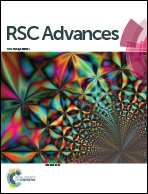Nepenthes-inspired multifunctional nanoblades with mechanical bactericidal, self-cleaning and insect anti-adhesive characteristics†
Abstract
In order to reduce the widespread threat of bacterial pathogen diseases, mechanical bactericidal surfaces have been widely reported. However, few of these nanostructured surfaces were investigated from a sustainable perspective. In this study, we have prepared, inspired by the slippery zone of Nepenthes, a multifunctional nanostructured surface with mechanical bactericidal, self-cleaning and insect anti-adhesive characteristics. First, a nanoblade-like surface made of Zn–Al layered double hydroxides was prepared for achieving faster bactericidal rate and wider bactericidal spectrum (2.10 × 104 CFU cm−2 min−1 against Escherichia coli and 1.78 × 103 CFU cm−2 min−1 against Staphylococcus aureus). Then the self-cleaning and insect anti-adhesive properties were tested on the fluorosilane-modified nanoblades, leaving little cell debris remaining on the surface even after 4 continuous bactericidal experiments, and showing a slippery surface for ants to slide down in 3 s. This study not only discovers a new nature-inspired mechanical bactericidal nanotopography, but also provides a facile approach to incorporate multiple functions into the nanostructured surface for practical antibacterial applications.



 Please wait while we load your content...
Please wait while we load your content...